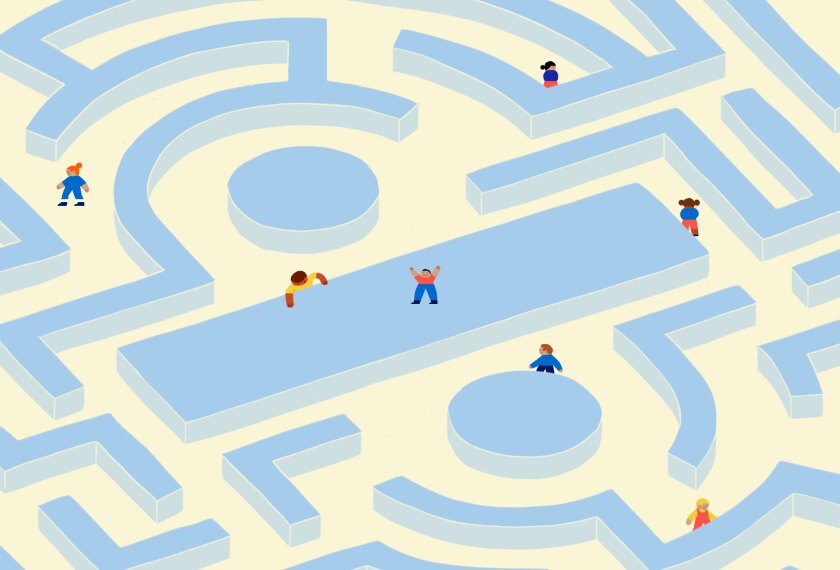With the return to school comes a return to students sitting at their desks for hours every dayŌĆöand teachersŌĆÖ subsequent challenge of managing those fidgeting students. There has been considerable research and emphasis on incorporating physical activity into learning through brain breaks or brief energizers, and I have found implementing it in my own classroom to yield positive results.
Considering movement integration through this lens falls short, however. Students, especially younger ones, need more than just brief breaks to move the body before resuming sitting and learning. Movement can .
Movement integration more commonly appears in literacy curricula, as movement can help develop phonemic awareness and letter-sound recognition. A reading program might, for instance, ask .
Seeing the advantage of connecting movement with content, I was curious if this benefit would extend to other subjects. While completing my masterŌĆÖs degree in early-childhood education, I researched the extent to which movement could improve math instructional strategies by building number sense and fact fluencyŌĆöthe numerical equivalents of letter-sound recognition and phonemic awareness.
Indeed, movement integration works particularly well with elementary math lessons, as it offers students a chance to engage physically with abstract concepts and demonstrate their understanding kinesthetically. For instance, a kindergartner struggling to conceptualize the value of teen numbers may find some benefit in using manipulatives, but even then, counting 14 Unifix cubes is a largely visual task.
When some of my 1st graders struggled to count backward from 20, I had them stand in a line and take turns counting down and jumping backward when it was their turn. Instead of simply reciting words they did not understand the value of, they watched the concept come to life as they physically moved in accord with the counting.
Another teaching strategy rooted in movement integration may look like having students do 10 jumping jacks and then switch to clapping four times. This exercise forces the students to count and be cognizant of when they reach 10. The switch to clapping after the first set of 10 allows them to make the connection that teen numbers are 10 plus some more ones.
Students learn as they move, and doing so reduces the need to take movement breaks unrelated to the lesson. This allows learning to continue uninterrupted by planned breaks, inevitable teacher redirections, or distracted students.
As pediatric occupational therapist Angela Hanscom explains in her book Balanced and Barefoot, ŌĆ£In order to appeal to all types of learners, it is best to incorporate movement into the actual learning experience.ŌĆØ In fact, she asserts that short bouts of movement unconnected to learning, for example sitting on a bouncy ball or wiggle breaks, ŌĆ£may also distract most children and actually hinder their learning.ŌĆØ Movement integration must therefore be strategically implemented.
So, how do we, as teachers, provide students with meaningful educational experiences that capitalize on a childŌĆÖs need to learn? Consider implementing some of the following movement-integration techniques into your elementary math lessons for improved engagement and understanding.
- Switching movements. As described in the teen-numbers example, this strategy uses physical movements that change at different intervals to allow children a kinesthetic option for developing number sense. Students do a movement for a set amount of times and then switch to a different movement, such as 10 high knees, then 10 frog jumps, then hops on one foot to conceptualize groups of 10.
- Skip movements. This strategy promotes skip-counting fluency by assigning different movements to different values. For instance, students may stand in a circle and count chorally but only say the even numbers aloud. When a student says a number, she steps forward; the next student simply claps. It would sound something like this: ŌĆ£Two, [clap], four, [clap], six, [clap], etc.ŌĆØ This exercise gets students in the habit of skip counting with a movement to account for the skipped numbers so that students do not get confused.
- Embodied movements. With this strategy, students become the concept. In other words, they use movements to represent a concept. An example may entail having students create shapes with their bodies; for example, four students could stretch out on the floor to create a square.
- Auditory and motion movements. This strategy can be helpful for reinforcing math rules and problem-solving steps. Using a verbal component, students recite the steps for solving a math problem or other math rule with movements to go along with the words. It can be a rhyme or song, but that is not a requirement for this practice to be successful.
(Several resources detail these strategies and more, such as Suzy KoontzŌĆÖ program.)
Why take time to integrate movement other than for the sake of movement? Research shows that movement-integration consistency yields statistically significant increases in math assessment scores, as well as increased curiosity in the subject. That curiosity, in turn, gives students greater sustained attention and, ultimately, an improved understanding .
The transition back to school does not have be a strain on seated learners wanting to move and frustrated teachers attempting to hold learners in their seats. Teaching strategies that integrate movement decrease the need for disruptive movement breaks. They also improve academic achievement overall.
The first time I told my students to do jumping jacks while counting aloud, they looked at me with confusion. Now, when I say that it is time for math, I am met with excitement and requests to start our lesson with one of the movement warm-ups with which we often begin. I have students that struggle with mental math who will clap or do small movements while working through a question as they conceptualize abstract concepts through physical engagement. This positive mindset toward math, coupled with kinesthetic learning, creates an ideal math instructional strategy for young learners.





